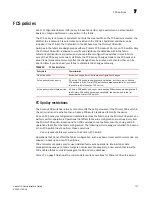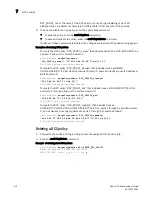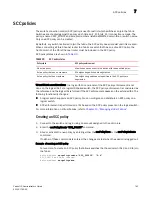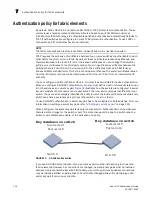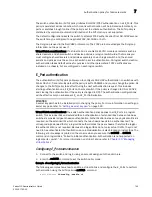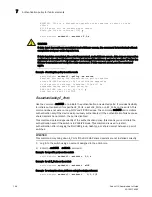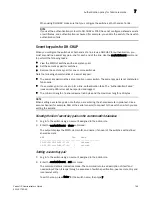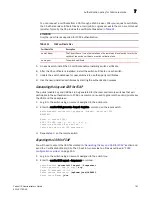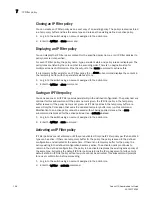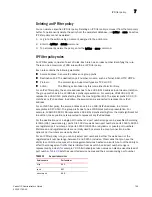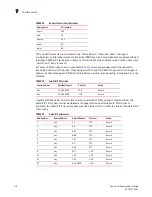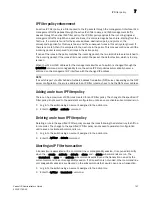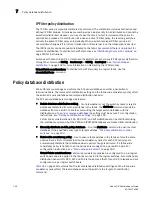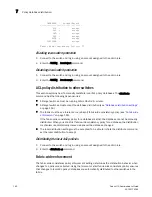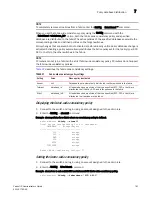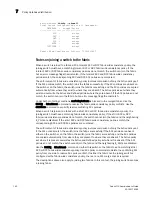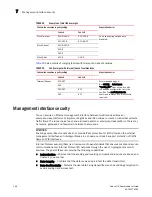
Fabric OS Administrator’s Guide
149
53-1001763-02
Authentication policy for fabric elements
7
When using DH-CHAP, make sure that you configure the switches at both ends of a link.
NOTE
If you set the authentication protocol to DH-CHAP or FCAP, have not configured shared secrets
or certificates, and authentication is checked (for example, you enable the switch), then switch
authentication fails.
Secret key pairs for DH-CHAP
When you configure the switches at both ends of a link to use DH-CHAP for authentication, you
must also define a
secret key pair
—one for each end of the link. Use the secAuthSecret command
to perform the following tasks:
•
View the WWN of switches with a
secret key pair.
•
Set the
secret key pair
for switches.
•
Remove the
secret key pair
for one or more switches.
Note the following characteristics of a
secret key pair
:
•
The
secret key pair
must be set up locally on every switch. The
secret key pair
is not distributed
fabric-wide.
•
If a
secret key pair
is not set up for a link, authentication fails. The “Authentication Failed”
(reason code 05h) error will be reported and logged.
•
The minimum length of a shared secret is 8 bytes and the maximum length is 40 bytes.
NOTE
When setting a
secret key pair
, note that you are entering the shared secrets in plain text. Use a
secure channel (for example, SSH or the serial console) to connect to the switch on which you are
setting the secrets.
Viewing the list of secret key pairs in the current switch database
1. Log in to the switch using an account assigned to the admin role.
2. Enter the secAuthSecret
--
show command.
The output displays the WWN, domain ID, and name (if known) of the switches with defined
shared secrets:
WWN DId Name
-----------------------------------------------
10:00:00:60:69:80:07:52 Unknown
10:00:00:60:69:80:07:5c 1 switchA
Setting a secret key pair
1. Log in to the switch using an account assigned to the admin role.
2. Enter the secAuthSecret
--
set command.
The command enters interactive mode. The command returns a description of itself and
needed input; then it loops through a sequence of switch specification, peer secret entry, and
local secret entry.
To exit the loop, press Enter for the switch name; then type y.
Summary of Contents for 53-1001763-02
Page 1: ...53 1001763 02 13 September 2010 Fabric OS Administrator s Guide Supporting Fabric OS v6 4 0 ...
Page 4: ...iv Fabric OS Administrator s Guide 53 1001763 02 ...
Page 24: ...xxiv Fabric OS Administrator s Guide 53 1001763 02 ...
Page 28: ...xxviii Fabric OS Administrator s Guide 53 1001763 02 ...
Page 32: ...xxxii Fabric OS Administrator s Guide 53 1001763 02 ...
Page 40: ...xl Fabric OS Administrator s Guide 53 1001763 02 ...
Page 42: ...2 Fabric OS Administrator s Guide 53 1001763 02 ...
Page 54: ...14 Fabric OS Administrator s Guide 53 1001763 02 High availability of daemon processes 1 ...
Page 74: ...34 Fabric OS Administrator s Guide 53 1001763 02 Basic connections 2 ...
Page 102: ...62 Fabric OS Administrator s Guide 53 1001763 02 Audit log configuration 3 ...
Page 214: ...174 Fabric OS Administrator s Guide 53 1001763 02 Management interface security 7 ...
Page 228: ...188 Fabric OS Administrator s Guide 53 1001763 02 Brocade configuration form 8 ...
Page 276: ...236 Fabric OS Administrator s Guide 53 1001763 02 Creating a logical fabric using XISLs 10 ...
Page 404: ...364 Fabric OS Administrator s Guide 53 1001763 02 ...
Page 440: ...400 Fabric OS Administrator s Guide 53 1001763 02 Performance data collection 17 ...
Page 480: ...440 Fabric OS Administrator s Guide 53 1001763 02 F_Port masterless trunking 19 ...
Page 494: ...454 Fabric OS Administrator s Guide 53 1001763 02 Buffer credit recovery 20 ...
Page 574: ...534 Fabric OS Administrator s Guide 53 1001763 02 Hexadecimal overview E ...



